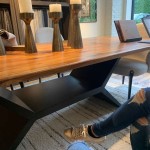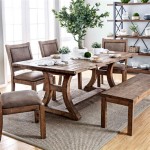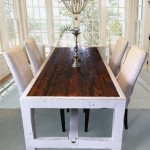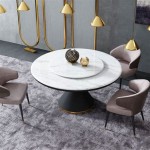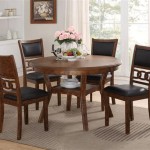Ultra Modern Dining Room Tables: A Comprehensive Guide
The dining room, historically a central gathering space for meals and conversation, is undergoing a stylistic transformation. Ultra-modern dining room tables are at the forefront of this evolution, reflecting a desire for clean lines, minimalist aesthetics, and innovative materials. These tables are not merely functional surfaces; they are design statements that can define the character of the entire dining space.
The term "ultra-modern" encompasses a range of design principles. Key aspects include a rejection of ornate details in favor of streamlined forms, the incorporation of new technologies in materials and construction, and a focus on creating a sense of spaciousness and visual harmony. Understanding these aspects is essential when selecting an ultra-modern dining room table that complements one's individual style and home architecture.
This article will explore the defining characteristics of ultra-modern dining room tables, examining the diverse materials used in their construction, showcasing prominent design trends, and providing guidance on selecting the right table for specific needs and spatial considerations. It will also delve into the importance of integration of the table with contemporary dining room themes.
Materials and Construction Innovation
One of the defining features of ultra-modern dining room tables is the creative and often unconventional use of materials. Traditional materials like wood are still employed, but they are often treated in new ways, such as bleached finishes for a minimalist look or combined with contrasting elements like metal or glass. Beyond wood, materials such as glass, metal, concrete, and acrylic resin are frequently used, each lending a distinct aesthetic and textural quality to the table.
Glass: Glass tabletops are common in ultra-modern designs due to their inherent transparency and ability to create a sense of lightness. Tempered glass, known for its strength and safety, is commonly used. Glass can be clear, frosted, tinted, or even textured, offering a range of visual effects. The transparency of glass allows the base of the table to remain visible, making it a focal point of the design. Glass is non-porous, making it easy to clean and resistant to stains. However, it is prone to scratches, and fingerprints can be easily visible.
Metal: Metal is a versatile material utilized in both the tabletop and the base of ultra-modern dining tables. Stainless steel, known for its durability and resistance to corrosion, is a popular choice. Other metals, such as aluminum and iron, are also used. Polished metal provides a sleek, reflective surface, while brushed metal offers a more subtle, matte finish. Metal can be shaped into complex geometric forms, allowing for innovative and visually striking table bases. Powder coating techniques can provide a durable, colored finish to metal components.
Concrete: Concrete is increasingly gaining popularity in ultra-modern furniture design. It offers a raw, industrial aesthetic that is both striking and versatile. Concrete tabletops are typically sealed to prevent staining and damage. Concrete can be cast into various shapes and sizes, allowing for customization and unique designs. Its weight makes it an exceptionally stable choice, but also limits its portability. Concrete adds a tactile element to the dining space, contrasting well with smoother materials like glass or metal.
Acrylic Resin: Acrylic resin, also known as Lucite or Plexiglas, is a synthetic material that is often used to create transparent or translucent furniture. It can be molded into various shapes and can be colored or left clear. Acrylic resin is durable and easy to clean, making it a practical choice for dining room furniture. Its transparency allows light to pass through, contributing to a sense of spaciousness. However, it can be prone to scratches and may require special cleaning products.
Wood: While often seen as a traditional material, wood finds a prominent place in ultra-modern design, albeit in refined and contemporary applications. Solid wood is still valued for its warmth and natural beauty. However, engineered wood, such as plywood or MDF, is also commonly used due to its stability and affordability. Wood finishes are carefully selected to complement the overall aesthetic, with options ranging from natural oiled finishes that highlight the wood grain to painted or lacquered surfaces that offer a more uniform and minimalist look. Wood can be combined with other materials, such as metal or glass, to create visually interesting contrasts.
Key Design Trends in Ultra-Modern Dining Room Tables
Ultra-modern dining room table designs are constantly evolving, reflecting changes in aesthetic preferences and technological advancements. Several key trends are shaping the current landscape, including geometric forms, minimalist aesthetics, cantilevered designs, and smart table technologies.
Geometric Forms: Geometric shapes, such as squares, rectangles, circles, and ovals, are fundamental elements in ultra-modern furniture design. Tables with sharp angles and clean lines are common, creating a sense of order and precision. Geometric bases can incorporate intersecting planes, creating visually dynamic structures. The use of negative space is also a key element, giving the table a lighter, more open feel. Complex geometric patterns can be incorporated into the tabletop or base, adding a touch of artistic flair.
Minimalist Aesthetics: Minimalism is a core principle of ultra-modern design. In the context of dining room tables, this translates to simple, uncluttered forms and a focus on functionality. Tables with sleek, streamlined silhouettes and minimal ornamentation are favored. The color palette is typically neutral, with shades of white, gray, black, and beige dominating. The absence of excessive details allows the quality of the materials and craftsmanship to take center stage. Minimalist tables are designed to blend seamlessly into the surrounding environment, creating a sense of spaciousness and tranquility.
Cantilevered Designs: Cantilevered designs, where the tabletop is supported by an off-center base, are a striking feature of many ultra-modern dining room tables. This design creates a sense of visual lightness and defies conventional structural norms. Cantilevered tables often feature a single, sculptural base that provides both support and visual interest. The cantilevered design allows for more legroom and creates a more open and inviting dining experience. Careful engineering is required to ensure the stability and safety of cantilevered tables. The design aesthetic draws inspiration from mid-century modern movement with a focus on functional art forms.
Smart Table Technologies: The integration of technology is becoming increasingly common in ultra-modern furniture. Smart dining tables can incorporate features such as built-in wireless charging, integrated lighting, and even interactive displays. Wireless charging pads can be seamlessly integrated into the tabletop, allowing users to charge their devices while dining. Integrated LED lighting can provide ambient illumination or highlight specific features of the table. Interactive displays can be used to access recipes, stream videos, or even play games. These features enhance the functionality of the dining table and transform it into a central hub for entertainment and communication.
Selecting the Right Ultra-Modern Dining Room Table
Choosing the right ultra-modern dining room table requires careful consideration of several factors, including the size of the room, the number of people who will typically use the table, the overall design aesthetic, and the budget. Proper measurement and thoughtful design integration is vital for the final look.
Size and Shape Considerations: The size of the dining room is a primary factor in determining the appropriate size and shape of the table. In smaller spaces, a round or oval table can be a good choice, as it allows for easier movement around the room. Rectangular tables are better suited for larger spaces, as they can accommodate more people. It is important to leave ample space around the table for chairs and traffic flow. A general guideline is to allow at least 36 inches of space between the table and any walls or furniture.
Seating Capacity: The seating capacity of the table should be based on the number of people who will typically use the table. A good rule of thumb is to allow at least 24 inches of width per person. For rectangular tables, the length should be sufficient to accommodate the desired number of seats. For round or oval tables, the diameter should be large enough to provide adequate space for each diner. Consider the potential for additional guests and choose a table that can comfortably accommodate a larger group when needed.
Style Compatibility: The style of the dining room table should complement the overall aesthetic of the space. Consider the existing furniture, décor, and architectural features. If the room has a minimalist design, a simple, uncluttered table with clean lines will be a good fit. If the room has a more industrial aesthetic, a table with a concrete or metal base may be more appropriate. Pay attention to the color palette and choose a table that harmonizes with the existing colors in the room. Consider the other elements, like the chairs. Chairs should complement the tables, never overpower it.
Budget and Quality: Ultra-modern dining room tables can range widely in price, depending on the materials used, the complexity of the design, and the brand. Set a budget before beginning the shopping process and stick to it. While it is tempting to opt for the cheapest option, it is important to consider the quality of the materials and construction. A well-made table will last longer and provide a better dining experience. Read reviews and compare prices from different retailers before making a purchase.
In conclusion, ultra-modern dining room tables offer a diverse range of options for homeowners seeking to create a stylish and functional dining space. By understanding the key characteristics of ultra-modern design, including the materials used, the prominent design trends, and the factors to consider when selecting a table, individuals can make informed decisions that result in a beautiful and well-suited dining area.

Ultra Modern Dining Room

Emmett Dining Table Solid Wood Nordic Style Retro

Cattelan Italia Spyder Wood Dining Table Wooden Contemporary Room Furniture Ultra Modern

Sheldon Ultra Slim Wooden Dining Table 140l X 60w 75h Oak None

Simo Modern Sintered Stone Dining Table 200l X 90w 75h

Ultramodern Classic Elegant Look Luxurious Marble Top Dining Table Set Lixra Com

50 Modern Dining Room Designs For The Super Stylish Contemporary Home

Flynn Modern Ultra Slim Solid Wood Dining Table 180cm

Gainsville Dining Room Furniture Stainless Steel Frame Marble Top Modern Tables Set China Table Design Made In Com

Bontempi Fiandre Wooden Dining Table Contemporary Room Furniture Ultra Modern



